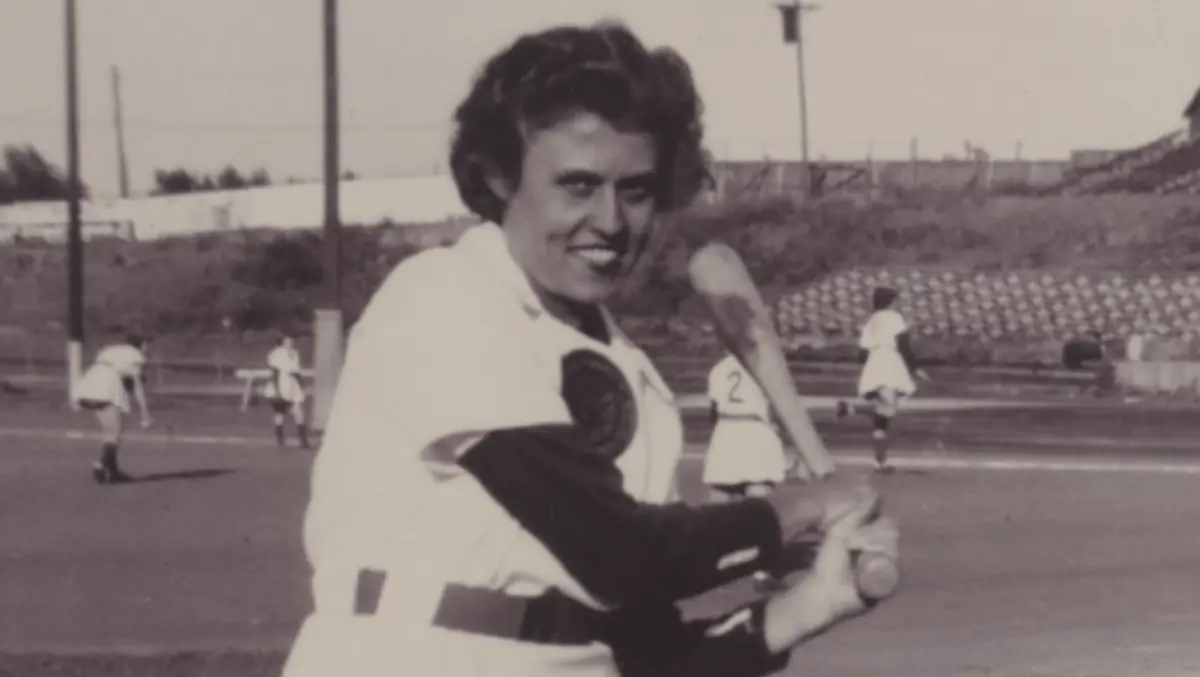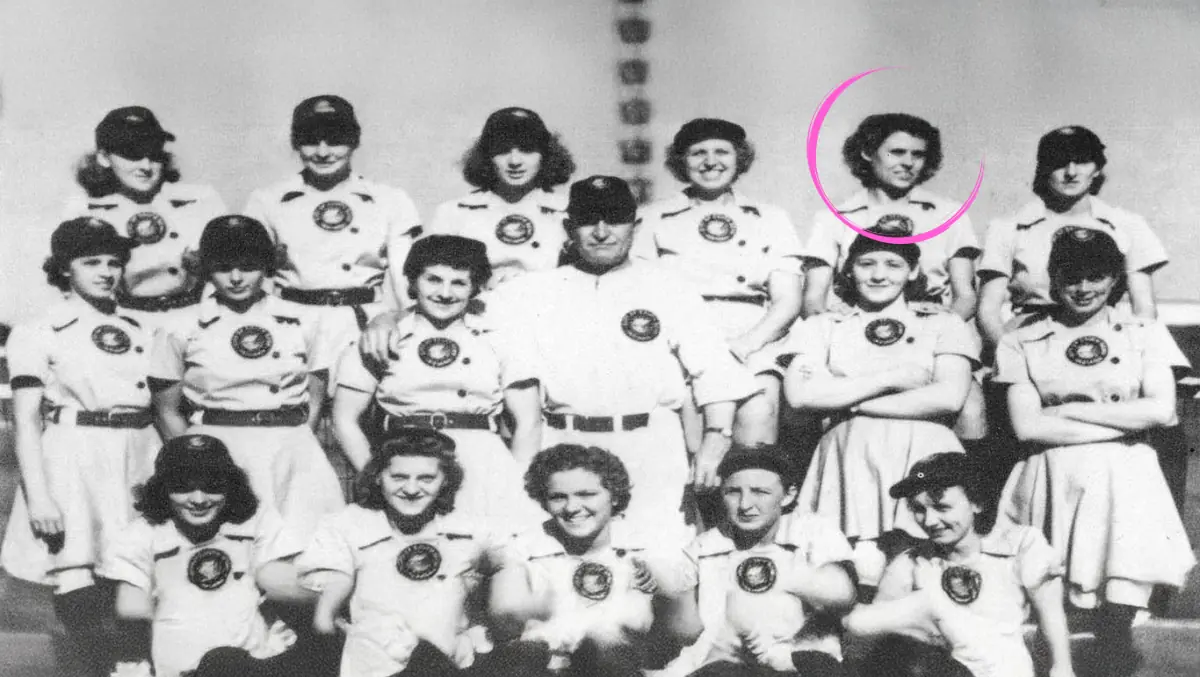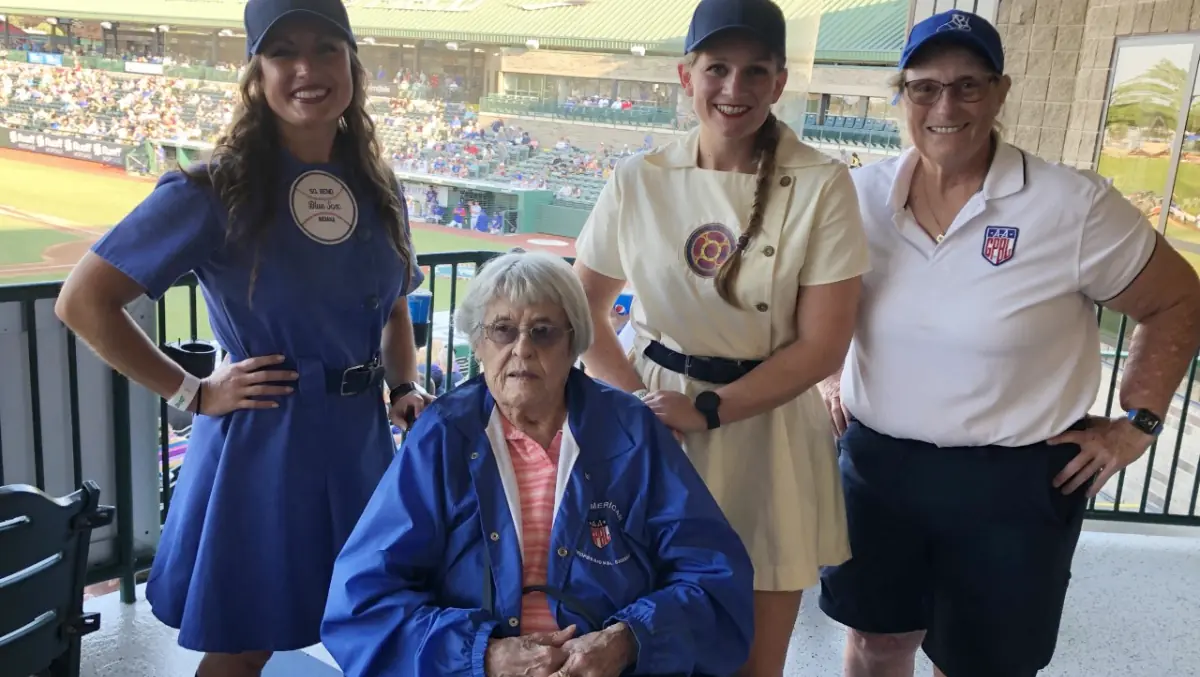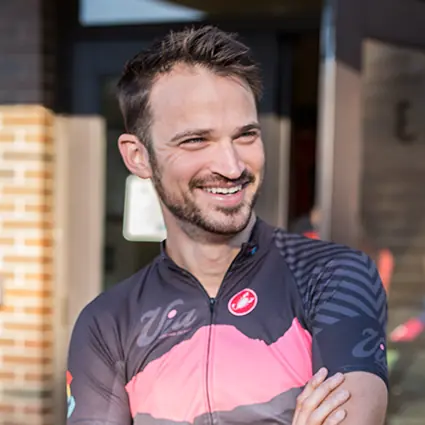HISTORY
SPORTS
Most Of All, She Was a Ballplayer: Remembering Betsy Jochum
Inaugural member of the South Bend Blue Sox came to town in 1943… and she never left.
BY AARON HELMAN // POSTED JUNE 2, 2025

Betsy Jochum was an early star — and the best hitter — for the Blue Sox when the team arrived in South Bend in 1943.
It was May of 1943 the first time Betsy Jochum — a fresh-faced 22-year-old from Cincinnati — arrived in South Bend. She'd been selected as one of the inaugural players in the All-American Girls League, and was assigned to a South Bend squad that didn't even have a name yet. Soon enough, they'd become the Blue Sox, and Betsy “Sockum” Jochum would become one of their biggest stars.
As for South Bend, it would become the last place Jochum ever called home.
Jochum, who passed away on May 31, 2025 at the age of 104, was the oldest living alum of the All-American League. After her time in professional baseball came to an end, Jochum remained in South Bend. She worked for Bendix for a spell, then got her degree and spent 27 years as a teacher at Muessel School. There was a time when her role in the All-American League was faded and forgotten, but that changed with the release of A League of Their Own.
Betsy Jochum will be remembered as a pioneer, a trailblazer, a heroine, a teacher, a friend, a local celebrity, and a community fixture for more than 80 years. But if Betsy had her way, she'd probably want to be remembered as a ballplayer.
So that's exactly what we're going to try to do.
When Phillip Wrigley dreamed up the idea for the All-American League — a bet against a world war that threatened to shut down Major League Baseball — he dispatched scouts to scour the Midwest for the best female ballplayers. They visited diamonds and schoolyards, took out ads in local papers inviting players to local and regional tryouts.
Many of the league's earliest players were complete unknowns: farmhands who'd grown up playing ball with their brothers, star athletes from rural enclaves that no one had heard of, and quiet girls with a dream and no name recognition.
But Betsy Jochum wasn't one of them.
Born and raised in Cincinnati, Jochum was already something of a legend across that metro for her athletic exploits. She played semi-professional softball for a company team and was the best player in the city. Her squad participated in tournaments across the nation, and her reputation as one of the best athletes of her time was solidified in 1938. That's when she — at the age of 17 — threw a baseball 276 feet at a national competition. The only woman who could best that mark was a 27-year-old Babe Zaharias.
The All-American League knew they wanted Betsy Jochum almost from the moment the circuit was imagined, and for Jochum, there might have been nothing in the world she wanted more. It had been unimaginable just a few years earlier, but Jochum was going to get to be a professional ballplayer. She reported for the tryout in Chicago and made it through every round of cuts to be among the 60 inaugural members of the new league.

Official team photo of the 1943 South Bend Blue Sox. Betsy "Sockum" Jochum is circled.
During her six years in the league, Jochum saw a lot of transition. She played through four managerial changes and evolved her playing style along with the league's rules — beginning with underhand pitching in 1943, sidearm pitching in 1946, and fully overhand in pitching in 1948.
During the league's inaugural season, Jochum hit .273 and swiped 66 bases, making her an easy selection to the circuit's first All-Star Game at Wrigley Field. She went hitless in that contest, played beneath temporary lights in front of more than 10,000 fans. When someone tells you that Wrigley Field didn't host its first night game until 1988, feel free to tell them they're off by more than 40 years.
That first night game happened in 1943, and Betsy Jochum was the starting right fielder for the home team.
Jochum followed up her 1943 All-Star season with an even better showing the next year, finishing as 1944's batting champion and adding 127 stolen bases to go with 40 walks against just 16 strikeouts. As base stealer, Jochum was prodigious. In her six seasons in the league, the Blue Sox star reached base 768 times and finished her career with 358 steals.
But as the league transitioned to overhand pitching, Jochum's legendary cannon of an arm was about to be put to a different use, and it might have seemed like the best was yet to come.
Betsy Jochum spent spring of 1948 learning how to harness the impressive weapon that was attached to her right shoulder, and she entered that year's campaign as a true two-way player. She spent time on the mound, in right field, and even at first base.
But it was on the hill that she made the biggest impact. In her first season as a pitcher, and while she was still figuring the position out, Jochum pitched her way to a miniscule 1.51 ERA across 29 starts. Bitten by bad luck, poor defense, and even worse run support, Jochum was rewarded with a record of 14-13.
Still, there was no doubt that the experiment had been a success. Jochum's manager encouraged her to ask for a raise ahead of the next season since she had thoroughly proved herself as a two-way player. She heeded the man's advice and asked the team's President for a pay bump.
Indignant and unimpressed with Jochum's barely .500 record as a starting pitcher, the President responded by trading his star away to Peoria.
Jochum had become comfortable in South Bend and had no desire to move to Peoria. She retired from the league rather than accept the trade. Her professional baseball career ended with a thud, leaving fans and onlookers to wonder what might have been.

Betsy Jochum celebrates her 100th birthday at Four Winds Field.
Sockum Jochum never did win a championship with the Blue Sox. South Bend's championship years came in 1951 and 1952, a few year's after Jochum's retirement. Even so, the legend of Jochum's exploits remain part of the fabric of the history of the team in South Bend.
There was the time she chased after a long fly ball only to realize that she'd misjudged the thing, reaching up at the last moment to snag the ball clean with her bare hand.
There was her first-ever appearance on the mound, a two-hit complete game shutout.
There was a home run in Minneapolis hit so hard that the newspaperman was sure the ball would have sailed out of a Major League park if it had the chance.
There was the time she swiped seven bags in a single game.
Betsy Jochum was a true five-tool player in a league that required its players to also be feminine, graceful, and friendly. She was all of those things too, and none of her teammates — or opponents — ever had an unkind thing to say about Sockum Jochum.
Of course, there was everything else. The bachelor's and master's degrees. The competitive bowling, tennis, golf, and badminton. The long teaching career. Traveling to watch the filming of A League of Their Own. Meeting Madonna. A uniform on display at the Smithsonian. More than 80 years of a life spent in her adopted hometown of South Bend.
But more than anything else, Betsy Jochum was a ballplayer.
And she was one hell of a ballplayer.
Aaron Helman is an author, historian and adventurer from South Bend. You may have seen him around South Bend drinking coffee. Learn more about his work or check out his books at
aaronhelman.com.




